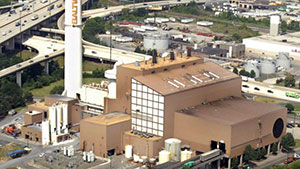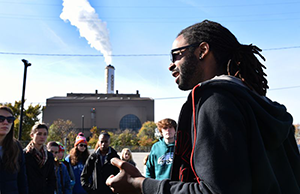Loyola student advocates for environmental justice in Baltimore
Madeline Fischer, class of 2020, wrote the following essay for WR 301: Writing about Science. In late 2017, Maddy attended a “toxic tour” of Baltimore, which was arranged by Dr. Elizabeth Dahl, Associate Professor of Chemistry. The tour took students through some of South Baltimore’s distressed neighborhoods, revealing that some of our city’s poor and low-income residents have no choice but to live side-by-side with industrial pollution. Maddy was profoundly moved by this experience, and she began following news stories about Baltimore’s air quality and informing everyone she knew about the environmental injustices in our city. Maddy’s essay, “The Real Wheelabrator,” which she wrote for her spring 2019 seminar, WR 301: Writing about Science, reveals how deeply she has internalized Loyola’s vision and core values. Maddy exercises leadership through her practice of eloquentia perfecta, applying her skills and talents to advocate on behalf of others.
Terre Ryan
Associate Professor, Writing Department
The Real Wheelabrator
By Madeline Fischer, ’20
Marketing major, Environmental and Sustainability Studies minor
 In December 2017, I found myself breathing in the crisp air that up until that point,
I had no reason to second guess. I was attending the “Toxic Tour,” which is as daunting
as the name suggests. Coordinated by Dr. Dahl, this tour takes students around Baltimore
to showcase different points in the city and highlight areas that contribute to why
Baltimore has the most polluted air in Maryland. After attending this tour, my eyes
have been opened to issues I never considered before.
In December 2017, I found myself breathing in the crisp air that up until that point,
I had no reason to second guess. I was attending the “Toxic Tour,” which is as daunting
as the name suggests. Coordinated by Dr. Dahl, this tour takes students around Baltimore
to showcase different points in the city and highlight areas that contribute to why
Baltimore has the most polluted air in Maryland. After attending this tour, my eyes
have been opened to issues I never considered before.
 Wheelabrator, an unassuming smokestack, was one of the focuses of the tour. What appears
to be a standard industrial eyesore to the commuters driving on I-95 is actually the
largest polluter in the whole city. Wheelabrator is an incinerator that burns waste
collected from Baltimore City and surrounding areas. It alone contributes 36% of all pounds of industrial air pollution in Baltimore. For comparison, the second runner up is
the Grace Chemical Plant, which is responsible for only a third as much pollution.
Wheelabrator, an unassuming smokestack, was one of the focuses of the tour. What appears
to be a standard industrial eyesore to the commuters driving on I-95 is actually the
largest polluter in the whole city. Wheelabrator is an incinerator that burns waste
collected from Baltimore City and surrounding areas. It alone contributes 36% of all pounds of industrial air pollution in Baltimore. For comparison, the second runner up is
the Grace Chemical Plant, which is responsible for only a third as much pollution.
Despite the substantial amount of pollution caused by this incinerator, it is recognized as a Tier 1 energy source by Maryland’s Renewable Portfolio Standards. This categorization gives the incinerator extra funding to continue operating as a “waste-to-energy” facility, meaning that the trash burned at the Wheelabrator can, in turn, be used to power the city. Although idealistic in theory, that is not the reality of Wheelabrator. A nuclear reaction would be necessary to truly turn waste into useable energy, so the use of this term is greatly misleading. Even more misleading is the impression that this is the best option when in reality, recycling and composting the same materials would save three to five times more energy than the trash incinerator claims to create by burning them. Yet, the policymakers who set these standards allowed incinerators to be included as a top tier energy source, therefore preventing more funding from being allocated towards actual sustainable options, such as wind or solar energy. Trash incinerators are actually the most polluting way to manage waste at all. Thirty percent of the waste burned at the Wheelabrator becomes ash and will be deposited in the Quarantine Road Landfill anyway, and the other seventy percent is released into the air as air pollution.
According to Wheelabrator Technologies, Wheelabrator Baltimore collected and burned 693,146 tons of trash this past year. That’s 485,202 tons worth of air pollution being deposited in Baltimore city! Typical air pollutants that are products of incinerators include carbon monoxide, hydrochloric acid, nitrogen oxides, sulfur oxide, and particulate matter, which is any mixture of extremely small particles and liquid droplets.
These harmful chemicals floating around in the air affect the citizens of Baltimore greatly. The average life expectancy for residents of the neighborhoods surrounding Wheelabrator is less than 70, which is almost a full decade lower than the state average. Of course, there are so many other factors that can be blamed for the discrepancy in life expectancies, but many local groups argue strongly that this is at least partially a direct result of the pollutants that Wheelabrator releases. Another, more direct, finding is that residents who live in Westport are two times as likely to die of lung cancer as residents living in more northern areas of Baltimore.
Further, the Baltimore City Department of Health reports that asthma is a bigger problem for Baltimoreans than it is for others, afflicting “12.4% of Baltimore City adults…compared to 8.4% statewide and 8.6% nationally.” But Baltimore City’s children suffer most, with asthma rates “more than twice the national average—20% vs. 9.4% respectively.”
 Our tour guide, Dante Swinton, a representative from Energy Justice Network, did more
than just tell us these facts and numbers about polluters in Baltimore. We were able
to see firsthand how pollution affects the environment and in turn, the community.
Swinton introduced the term “environmental racism” to us, meaning “the unequal protection against toxic and hazardous waste exposure
and the systematic exclusion of people of color from environmental decisions affecting
their communities.” Learning that term changed my perception of Baltimore; I couldn’t
go anywhere in the city without now thinking of it. Whether it was the lack of polluting
factories in a wealthier neighborhood or the obscene number of them in the more impoverished
areas, I noticed it. Understanding environmental racism is key to seeing how unethical
it is to keep the Wheelabrator active in Baltimore, since it affects directly the
lives of the residents who don’t have a means of advocating for their own environmental
justice. That’s where Energy Justice Network comes in.
Our tour guide, Dante Swinton, a representative from Energy Justice Network, did more
than just tell us these facts and numbers about polluters in Baltimore. We were able
to see firsthand how pollution affects the environment and in turn, the community.
Swinton introduced the term “environmental racism” to us, meaning “the unequal protection against toxic and hazardous waste exposure
and the systematic exclusion of people of color from environmental decisions affecting
their communities.” Learning that term changed my perception of Baltimore; I couldn’t
go anywhere in the city without now thinking of it. Whether it was the lack of polluting
factories in a wealthier neighborhood or the obscene number of them in the more impoverished
areas, I noticed it. Understanding environmental racism is key to seeing how unethical
it is to keep the Wheelabrator active in Baltimore, since it affects directly the
lives of the residents who don’t have a means of advocating for their own environmental
justice. That’s where Energy Justice Network comes in.
The Energy Justice Network is a group that campaigns for environmental justice all over the United States. They are the ones who put on the Toxic Tour, and they are the reason my eyes have been opened to the environmental racism that happens so frequently in Baltimore and elsewhere. And, as of March 7, 2019, they are responsible for the signing of the Baltimore Clean Air Act.
This act will raise the emissions standards for incinerators in Baltimore that have a capacity of 25 tons or more, require monitoring of 20 major pollutants that are released from incineration, and require qualifying facilities to install pollution controls to minimize their emissions. Due to these strict guidelines, the Wheelabrator will not be able to comply and will be forced to shut down in the near future.
I have been studying environmental sustainability at Loyola for three years now, and still, Wheelabrator and the environmental racism occurring in this city have been the most immediately concerning matters to me. I followed the progress of Energy Justice Network for nearly two years as they strived to get the Baltimore Clean Air Act passed, and I participated alongside, though in a much smaller role, through informing as many people as I could about these issues. Now that the act has finally passed, I am hopeful that Baltimore’s air quality can change for the better, and that these improvements will act as a precedent to get other incinerators shut down. And until the day when there are no incinerators left, I am happy to spread the truth behind the real Wheelabrator.